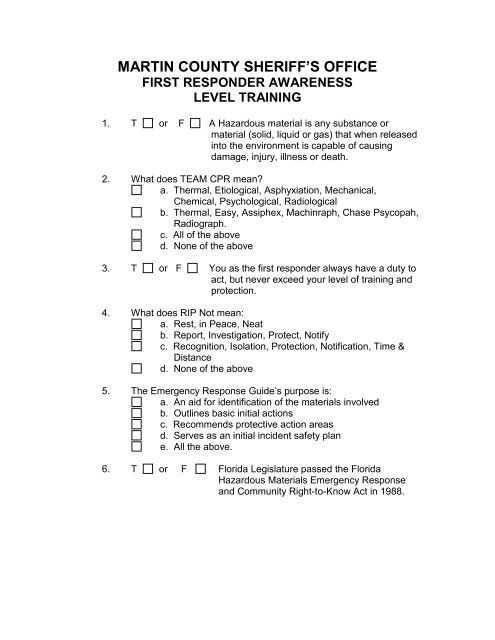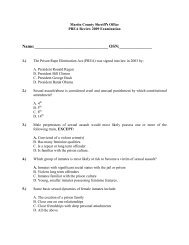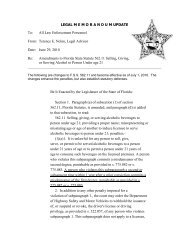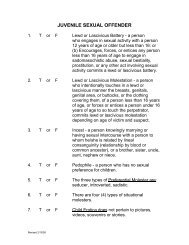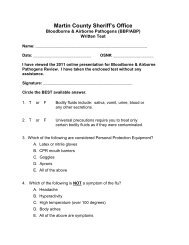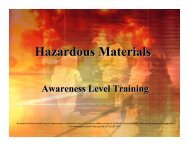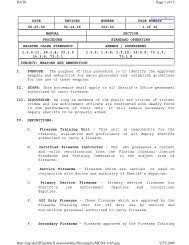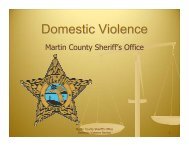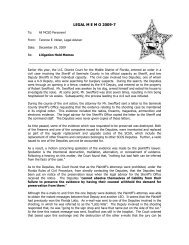HAZMAT Test.pdf - Martin County, Florida
HAZMAT Test.pdf - Martin County, Florida
HAZMAT Test.pdf - Martin County, Florida
You also want an ePaper? Increase the reach of your titles
YUMPU automatically turns print PDFs into web optimized ePapers that Google loves.
MARTIN COUNTY SHERIFF’S OFFICE<br />
FIRST RESPONDER AWARENESS<br />
LEVEL TRAINING<br />
1. T or F A Hazardous material is any substance or<br />
material (solid, liquid or gas) that when released<br />
into the environment is capable of causing<br />
damage, injury, illness or death.<br />
2. What does TEAM CPR mean?<br />
a. Thermal, Etiological, Asphyxiation, Mechanical,<br />
Chemical, Psychological, Radiological<br />
b. Thermal, Easy, Assiphex, Machinraph, Chase Psycopah,<br />
Radiograph.<br />
c. All of the above<br />
d. None of the above<br />
3. T or F You as the first responder always have a duty to<br />
act, but never exceed your level of training and<br />
protection.<br />
4. What does RIP Not mean:<br />
a. Rest, in Peace, Neat<br />
b. Report, Investigation, Protect, Notify<br />
c. Recognition, Isolation, Protection, Notification, Time &<br />
Distance<br />
d. None of the above<br />
5. The Emergency Response Guide’s purpose is:<br />
a. An aid for identification of the materials involved<br />
b. Outlines basic initial actions<br />
c. Recommends protective action areas<br />
d. Serves as an initial incident safety plan<br />
e. All the above.<br />
6. T or F <strong>Florida</strong> Legislature passed the <strong>Florida</strong><br />
Hazardous Materials Emergency Response<br />
and Community Right-to-Know Act in 1988.
7. According to the 2008 Emergency Response Guidebook, for a<br />
large spill of compressed gas, toxic oxidizing, corrosive NOS (Not<br />
Otherwise Specified) Inhalation Hazard Zone C, i.d. #3306 you<br />
must isolate ________ in all directions.<br />
a. 100 ft<br />
b. 500 ft<br />
c. 750 ft<br />
d. 1,000 ft<br />
8. T or F The six basic clues to recognition are<br />
- occupancy and location<br />
- container shape and size<br />
- placards and labels<br />
- shipping papers/facility documents<br />
- markings and colors<br />
- human senses<br />
9. T or F The five modes of hazardous material<br />
transportation are rail, air, marine, highway,<br />
and pipeline.<br />
10. According to the 2008 Emergency Response Guidebook, what<br />
page number in the blue pages would you find the material Copper<br />
Cyanide?<br />
a. 113<br />
b. 117<br />
c. 135<br />
d. 103<br />
11. Some classifications of containers are:<br />
a. Portable<br />
b. Fixed<br />
c. Transportation<br />
d. All of the above<br />
12. Explosives are divided up in subdivision. Some of these are:<br />
a. Mass explosion hazard<br />
b. Projectile hazard<br />
c. Very insensitive explosives<br />
d. All the above<br />
13. There are nine hazard classes. Some of these are:<br />
a. Explosives & gas<br />
b. Flammable liquids & solids<br />
c. Toxic & infectious substances<br />
d. All of the above
14. Infectious substances can be the following:<br />
a. Human blood<br />
b. Anthrax<br />
c. Bleach and water<br />
d. A and B only<br />
15. Miscellaneous hazardous materials could be one of the following:<br />
a. Ice<br />
b. Quick Lime, Metallic Mercury & asphalt<br />
c. Cement<br />
d. None of the above<br />
16. You have a train derailment at NE Dixie Highway and SR 707. You<br />
see on one of the over turned rail cars a yellow placard with<br />
OXIDIZER on it. Where would you find the shipping papers and<br />
facility documents?<br />
a. With the conductor<br />
b. At the train terminal<br />
c. At the train dispatch center<br />
d. At the shipping company office<br />
17. What does MSDS stand for?<br />
a. Master Safety Data Sheets<br />
b. Manufactures Substance Data Sheets<br />
c. Material Safety Data Sheets<br />
d. None of the above<br />
18. T or F Colors on Containers are always standard?<br />
19. What does WMD stand for?<br />
a. Waste Material Destruction<br />
b. Weapon for Marine Details<br />
c. Weapon of Mass Destruction<br />
d. Weather Monitoring Device<br />
_____________________________________________________<br />
20. The difference between chemical versus biological incidents is,<br />
biological has:<br />
a. Rapid response<br />
b. Wide spread migration of the illness<br />
c. Gradual on set without odors or colors<br />
d. Natural indications<br />
e. B and C only
21. The proper steps for the use of the Emergency Response Guide<br />
Book is:<br />
a. Recognize and identify hazardous materials<br />
b. Look up guide page numbers<br />
c. Take basic protective actions according to the guide page<br />
d. All of the above<br />
22. A basic protective action in a hazardous material incident would be:<br />
a. Approach an incident from uphill and upwind<br />
b. Use binoculars to identify labeling<br />
c. Look for all hazards<br />
d. Relay hazards and safety information to others<br />
e. All of the above.<br />
23. Who implements the incident command system?<br />
a. You, the deputy sheriff<br />
b. The EMT-firefighter<br />
c. The senior response official<br />
d. All the above<br />
24. T or F To prevent secondary contamination, you<br />
should not allow anyone or anything to leave the area without being<br />
evaluated.<br />
25. T or F All deputies should have an Emergency<br />
Response Guidebook in their patrol cars.


